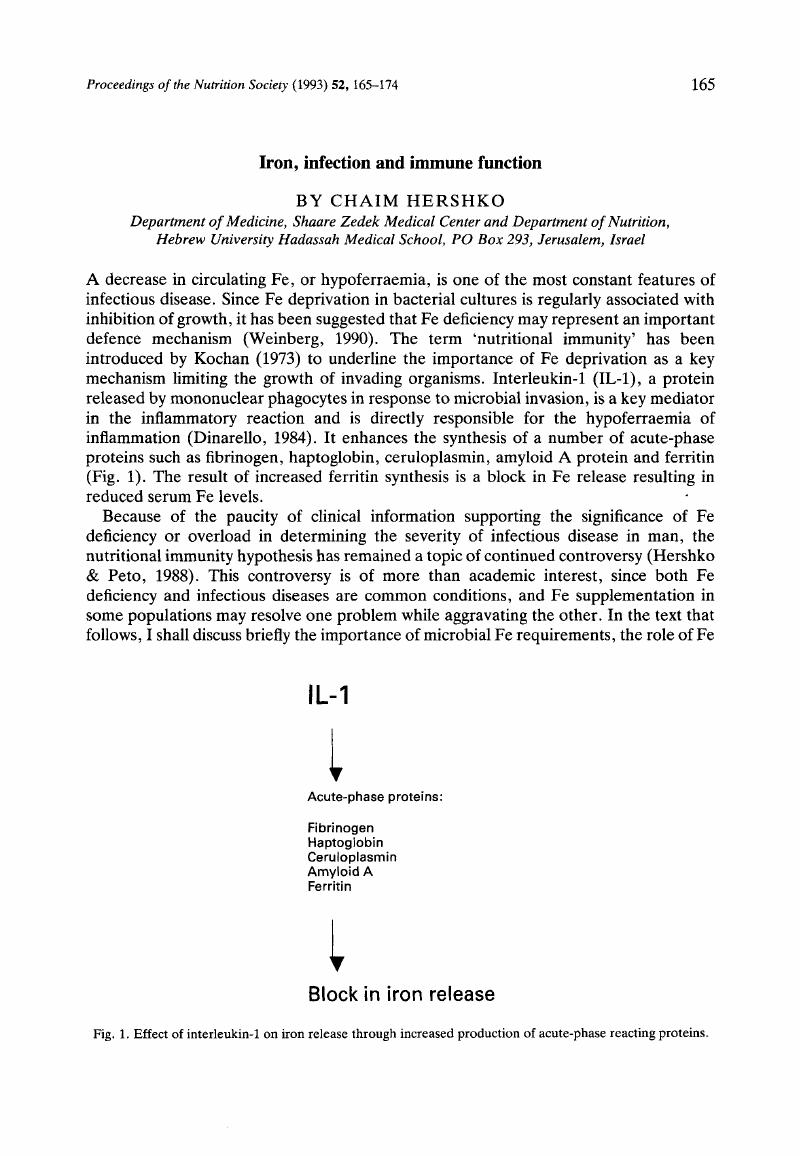Crossref Citations
This article has been cited by the following publications. This list is generated based on data provided by Crossref.
Cardoso, Marly A.
Ferreira, Marcelo U.
Ribeiro, Georgina S.
Penteado, Marilene D.V.C.
and
Andrade, Heitor F.
1996.
Dietary Iron Supplementation Does Not Aggravate Experimental Malaria in Young Rats.
The Journal of Nutrition,
Vol. 126,
Issue. 2,
p.
467.
Standal, H.
RØrvik, K. -A.
Lien, H.
and
Andersen, Ø.
1997.
Effects of acute iron overload on Atlantic salmon (Salmo salar) and rainbow trout (Oncorhynchus mykiss).
Biological Trace Element Research,
Vol. 59,
Issue. 1-3,
p.
13.
Sipahi, Tansu
Akar, Nejat
Egin, Yonca
and
Cin, Şükrü
1998.
Serum Interleukin-2 and Interleukin-6 Levels in IRON Deficiency Anemia.
Pediatric Hematology and Oncology,
Vol. 15,
Issue. 1,
p.
69.
Krause, Deanna
Mastro, Andrea M
Handte, Gordon
Smiciklas-Wright, Helen
Miles, Mary P
and
Ahluwalia, Namanjeet
1999.
Immune function did not decline with aging in apparently healthy, well-nourished women.
Mechanisms of Ageing and Development,
Vol. 112,
Issue. 1,
p.
43.
Kozel, T. R.
Nyhus, Karin J.
and
Jacobson, Eric S.
1999.
Genetic and Physiologic Characterization of Ferric/Cupric Reductase Constitutive Mutants ofCryptococcus neoformans.
Infection and Immunity,
Vol. 67,
Issue. 5,
p.
2357.
Bruininx, E.M.A.M
Swinkels, J.W.G.M
Parmentier, H.K
Jetten, C.W.J
Gentry, J.L
and
Schrama, J.W
2000.
Effects of an additional iron injection on growth and humoral immunity of weanling pigs.
Livestock Production Science,
Vol. 67,
Issue. 1-2,
p.
31.
Hor, Lien‐I
Chang, Yir‐kun
Chang, Chien‐chung
Lei, Huan‐yao
and
Ou, Jonathan T.
2000.
Mechanism of High Susceptibility of Iron‐Overloaded Mouse to Vibrio vulnificus Infection.
Microbiology and Immunology,
Vol. 44,
Issue. 11,
p.
871.
Soekarjo, DD
de Pee, S
Bloem, MW
Tjiong, R
Yip, R
Schreurs, WHP
and
Muhilal
2001.
Socio-economic status and puberty are the main factors determining anaemia in adolescent girls and boys in East Java, Indonesia.
European Journal of Clinical Nutrition,
Vol. 55,
Issue. 11,
p.
932.
Oppenheimer, Stephen J.
2001.
Iron and Its Relation to Immunity and Infectious Disease.
The Journal of Nutrition,
Vol. 131,
Issue. 2,
p.
616S.
Lynch, Sean
Stoltzfus, Rebecca
and
Rawat, Rahul
2007.
Critical Review of Strategies to Prevent and Control Iron Deficiency in Children.
Food and Nutrition Bulletin,
Vol. 28,
Issue. 4_suppl4,
p.
S610.
Hershko, Chaim
2007.
Mechanism of Iron Toxicity.
Food and Nutrition Bulletin,
Vol. 28,
Issue. 4_suppl4,
p.
S500.
Schümann, Klaus
Ettle, Thomas
Szegner, Bernadett
Elsenhans, Bernd
and
Solomons, Noel W.
2007.
On risks and benefits of iron supplementation recommendations for iron intake revisited.
Journal of Trace Elements in Medicine and Biology,
Vol. 21,
Issue. 3,
p.
147.
Ceni, Danieli Cátia
Martins, Laura Alegria
Pereira, Andréa Garcia
Fröehlich, Pedro Eduardo
and
Bergold, Ana Maria
2009.
An LC Ion-Pairing Method for the Determination of Fe(II) in Ferrous Bisglycinate Pharmaceutical Formulation.
Chromatographia,
Vol. 69,
Issue. S2,
p.
189.
Boersma, Wim J. A.
van der Meulen, Jan
and
Niewold, Theo A.
2009.
The Welfare of Pigs.
Vol. 7,
Issue. ,
p.
237.
Darnton-Hill, Ian
and
Ahmed, Faruk
2010.
Preventive Nutrition.
p.
567.
Oliveira Filho, José P.
Badial, Peres R.
Cunha, Paulo H.J.
Cruz, Taís F.
Araújo, João P.
Divers, Thomas J.
Winand, Nena J.
and
Borges, Alexandre S.
2010.
Cloning, sequencing and expression analysis of the equine hepcidin gene by real-time PCR.
Veterinary Immunology and Immunopathology,
Vol. 135,
Issue. 1-2,
p.
34.
Cho, J.H.
and
Kim, I.H.
2011.
d-Aminolevulinic Acid (ALA) as a Potential Feed Additive in Pig: A Review.
Journal of Animal and Veterinary Advances,
Vol. 10,
Issue. 13,
p.
1627.
da Silva, Cássia Bagolin
Wolkmer, Patrícia
Paim, Francine Chimelo
Da Silva, Aleksandro Schafer
Siqueira, Lucas Carvalho
de Souza, Camila Lopes
França, Raqueli Teresinha
Dornelles, Guilherme Lopes
Medeiros Frescura Duarte, Marta Maria
Monteiro, Silvia Gonzalez
Mazzanti, Cinthia Melazzo
and
dos Anjos Lopes, Sonia Terezinha
2013.
Iron metabolism and its relationship to anemia and immune system in Trypanosoma evansi infected rats.
Experimental Parasitology,
Vol. 133,
Issue. 3,
p.
357.
Cusick, Sarah
and
John, Chandy
2014.
Nutrition-Infection Interactions and Impacts on Human Health.
p.
39.
Schümann, Klaus
Ettle, Thomas
Szegner, Bernadett
Elsenhans, Bernd
and
Solomons, Noel W.
2014.
Risiken und Nutzen der Eisensupplementation: Empfehlungen zur Eisenaufnahme kritisch betrachtet.
Perspectives in Medicine,
Vol. 2,
Issue. 1-4,
p.
19.





